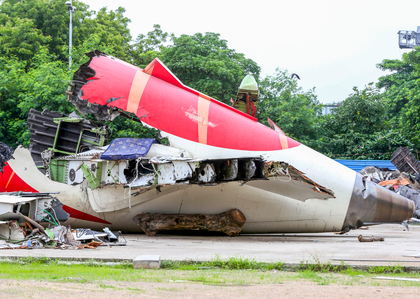Air India crash: Airlines check fuel locking mechanism in Boeing 787 aircraft
By IANS | Updated: July 14, 2025 15:54 IST2025-07-14T15:48:25+5:302025-07-14T15:54:15+5:30
New Delhi, July 14 After the Aircraft Accident Investigation Bureau’s (AAIB) preliminary report into the fatal Air India ...

Air India crash: Airlines check fuel locking mechanism in Boeing 787 aircraft
New Delhi, July 14 After the Aircraft Accident Investigation Bureau’s (AAIB) preliminary report into the fatal Air India crash was made public last week, airlines have started checking the locking mechanism in the fuel switches of Boeing 787 aircraft.
The initial report into the Air India plane crash in Ahmedabad mentioned about fuel cut-off to both engines shortly after take-off, leading to the deadly crash. Experts have already said the locking feature of the switches may have malfunctioned.
The AAIB report also said there was no “recommended action” for either Boeing, the maker of the aircraft, or GE, the engine manufacturer, at this time.
Etihad Airways has now asked its engineers to inspect the locking mechanism of the fuel control switches in the B-787 aircraft, asking them to be careful while operating the switches.
In its safety circular or “standard work package” for its engineering team, Etihad Airways asked them to fully inspect the fuel control switch locking feature for “proper engagement”.
“Attempt to gently move (without applying excessive force) the Left (L) fuel control switch on the P10 Control Stand from ‘CUT-OFF’ to ‘RUN’ without lifting the switch,” the circular said. “If the switch cannot be moved without lifting, the locking feature is functional. No further action is required. Proceed to the next step,” it added.
According to the AAIB report, Air India plane’s engine 1 and engine 2 fuel cut-off switches transitioned from RUN to CUT-OFF position one after another with a time gap of just 1 second.
In the cockpit voice recording, one of the pilots is heard asking the other why did he cut off the fuel, to which the other pilot responded that he "did not do so."
Meanwhile, the US Federal Aviation Administration (FAA) has informed civil aviation authorities of other countries that fuel control switch designs, including the locking feature, installed in Boeing planes, including the Dreamliner involved in the Air India crash at Ahmedabad, are safe.
The AAIB report also mentioned a FAA's 2018 bulletin that had warned of a potential malfunction of the fuel control switches, manufactured by US-based Honeywell, in a few Boeing models such as the 737s which also uses the same switches.
The bulletin recommended that carriers operating Boeing models, including the Dreamliner, inspect the locking mechanism of the fuel 'cut-off' switches — a step not taken by Air India, according to the AAIB report.
Air India informed investigators that it did not carry out suggested inspections as they were "advisory” in nature and not “mandatory".
The 2018 bulletin “was based on reports that the fuel control switches were installed with the locking feature disengaged”, the FAA said in a notice. When asked for a comment, the FAA said it did not have anything to add beyond the notification.
Disclaimer: This post has been auto-published from an agency feed without any modifications to the text and has not been reviewed by an editor
Open in app